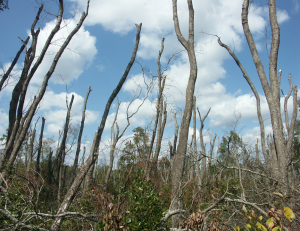
Carolina hemlock can thrive on rocky hillsides, ledges, or ridges — like this site on Mt. Jefferson, NC. Photo by Robert Jetton, NCSU.
Hemlocks are under attack. U.S. Forest Service scientists and their partners are working to save the native conifers from the hemlock wooly adelgid (HWA), an invasive insect from Japan. Carolina hemlock (Tsuga caroliniana) trees can survive HWA infestation for a decade or more but often die within four years.
Carolina hemlocks grow in tiny, isolated populations in the southern Appalachian Mountains. They are more closely related to Asian hemlocks than the more common, familiar eastern hemlock (Tsuga canadensis).
Part of the conservation strategy for Carolina hemlock is collecting seeds from the trees for gene banks, conservation planting, and future restoration efforts.
Kevin Potter, a population geneticist at North Carolina State University, along with U.S. Forest Service Southern Research Station research geneticist Dana Nelson and plant genetics lab technician Sedley Josserand and Camcore partners Angelia Campbell and Robert Jetton, wondered if Carolina hemlock’s small population size — combined with its isolation — might make the species susceptible to inbreeding and low genetic diversity.
This would make the species an especially urgent target for gene banking efforts.
The team conducted the most extensive seed sampling of Carolina hemlock populations to date. Their findings were published in Tree Genetics & Genomes.
“We learned that there are high levels of inbreeding in nearly all of the Carolina hemlock populations,” says Potter. “About half of the genetic differentiation occurred among populations, rather than within. That’s highly unusual for a conifer.”
“Carolina hemlock is a really unique and interesting tree. Its entire range is threatened by the hemlock wooly adelgid,” says Jetton. “Because it’s located on dry sites, it’s more susceptible to fire than eastern hemlocks.”
While scientists continue to refine and deploy HWA control measures, the hemlock seeds collected by Camcore can be used to restore populations that have suffered considerable mortality or loss of genetic variation. Restoration efforts will need to select seed sources close to the target sites because of the genetic differences between populations.
“We have to act immediately and quickly if we hope to preserve the genetic diversity of Carolina hemlock,” concludes Potter.
For more information, and a sound recording of Kevin Potter describing this project, see this blog posting from the U.S. Forest Service Southern Research Station.
November 14, 2017




